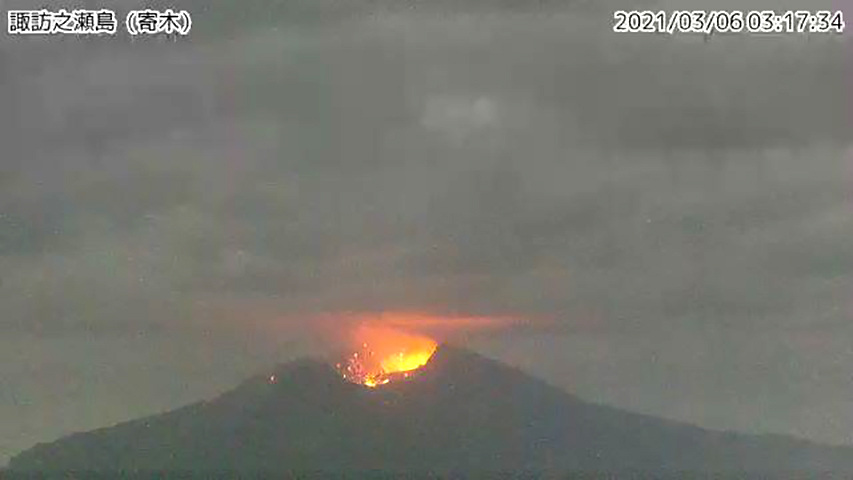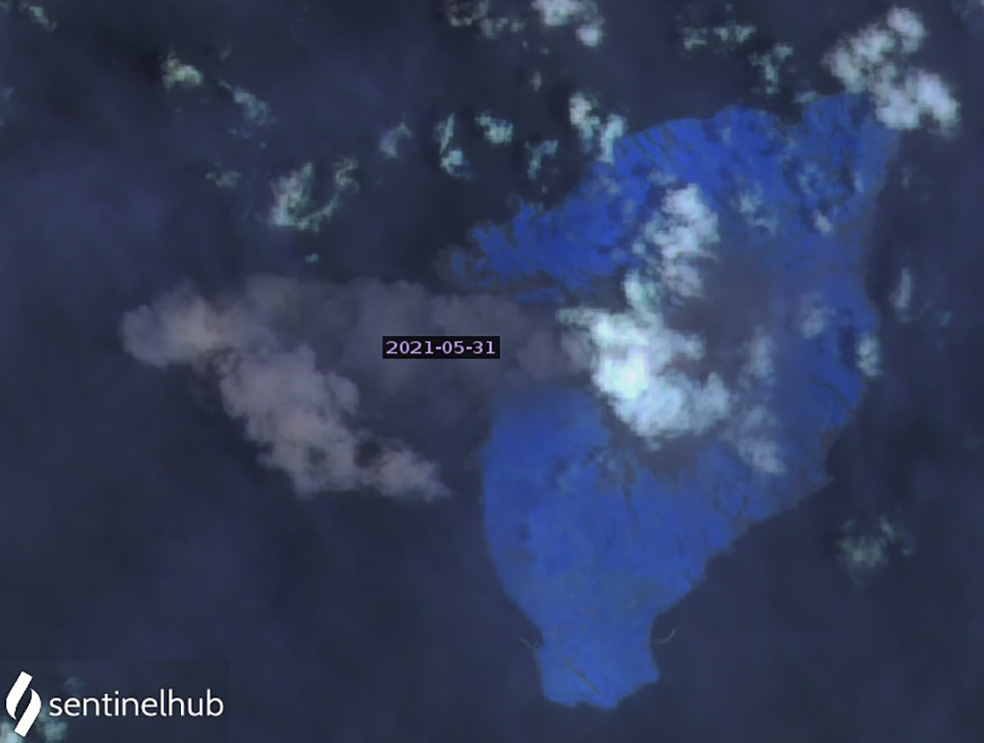Report on Suwanosejima (Japan) — September 2021
Bulletin of the Global Volcanism Network, vol. 46, no. 9 (September 2021)
Managing Editor: Edward Venzke.
Edited by A. Elizabeth Crafford.
Suwanosejima (Japan) Intermittent explosions send incandescent ejecta 1 km from summit during January-June 2021
Please cite this report as:
Global Volcanism Program, 2021. Report on Suwanosejima (Japan) (Crafford, A.E., and Venzke, E., eds.). Bulletin of the Global Volcanism Network, 46:9. Smithsonian Institution. https://doi.org/10.5479/si.GVP.BGVN202109-282030
Suwanosejima
Japan
29.638°N, 129.714°E; summit elev. 796 m
All times are local (unless otherwise noted)
Suwanosejima, an andesitic stratovolcano in Japan's northern Ryukyu Islands, was intermittently active for much of the 20th century, producing ash plumes, Strombolian explosions, and ashfall. Ongoing activity since October 2004 has included explosions which generate incandescent ejecta and ash plumes that rise hundreds of meters above the summit to altitudes between 1 and 3 km. Incandescence is often observed at night and ejecta periodically reaches as far as a kilometer from the summit. Ashfall is usually noted several times each month in the nearby community on the SW flank of the island. Ongoing activity for January-June 2021 is covered in this report with information provided by the Japan Meteorological Agency (JMA), the Tokyo Volcanic Ash Advisory Center (VAAC), and several sources of satellite data.
Intermittent pulses of explosive activity continued during January-June 2020. Ashfall was reported a few times each month in the village 4 km SW of the summit. Vibrations were felt there during the stronger explosive events, and summit incandescence was frequently observed with the surveillance camera located in the town. Most of the daily multiple explosions reached 1.2-1.8 km altitude and drifted in multiple directions, but several times each month ash emissions reached 2 km altitude or higher. Twice in March and once in June incandescent ejecta reached almost one kilometer from the summit crater, prompting JMA to raise the alert level. The MIROVA Log Radiative Power graph of the MODIS thermal anomaly data through June 2021 indicates intermittent pulses of increased thermal activity in late December 2020, March, and April 2021 that appear to correspond to increased periods of explosive activity (figure 58).
After a pulse of explosive activity at the end of December 2020, there was a decrease in activity during January 2021. This fact, along with no significant changes in the crustal movement data, led JMA to reduce the Alert Level from 3 (Mountain-entry restrictions) to 2 (Crater-area restrictions) on 14 January. No ejecta had traveled more than 1 km from the crater since late December. Only seven explosions were recorded during January compared with 460 in December 2020. Ash emissions rose up to 2,500 m above the crater rim, and ejecta traveled 400 m from the crater edge. During an overflight on 19 January JMA confirmed gray and white emissions at the summit and noted no particular changes to the crater since the previous observation on 28 December 2020. Numerous small explosions reported by the Tokyo VAAC rose to 1.2-1.8 km altitude and drifted in multiple directions, often S or SE, on most days during the month. During 15-16 January ash plumes rose to 2.0-2.4 km altitude and drifted NE. The highest plumes in January were reported on 20 and 21 January when they rose to 2.4 km and drifted W and E (figure 59).
Seven explosions were also recorded during February 2021; they produced ash plumes that rose 1,800 m above the crater rim, and scattered ejecta up to 500 m from the Mitake crater. Ashfall and vibrations were reported several times in the nearby village, and incandescence was sometimes visible at night. From 2-9 February the Tokyo VAAC reported intermittent ash emissions on most days that rose to 1.2-1.8 km altitude and drifted S or SE. On 13 February an ash plume rose to 2.1 km altitude and drifted W. Ash emissions appeared in Sentinel-2 satellite imagery drifting E on 20 February (figure 60). The Tokyo VAAC reported the emissions at 1.2-1.5 km altitude. During 23-26 February ash emissions were reported at 1.5-1.8 km altitude drifting S, SW, NW, and SE.
Two periods of increased explosive activity occurred during 2-7 and 30-31 March 2021; the number of explosions increased to 212 from the seven recorded during February. The Tokyo VAAC reported explosions with ash emissions that rose to 1.2-1.5 km altitude and drifted S and W during 1-5 March. Early on 6 March ejecta was thrown 900 m SE from the crater, followed by additional explosions that sent ejecta 400 m (figure 61). Ash plumes rose to 1.8-2.1 km altitude during 6-9 March. An ash emission reached 1,500 m above the crater (2.3 km altitude) on 15 March and an ash plume on 17 March reached 2.4 km altitude and drifted NE. Between 18 March and the end of the month the explosions sent plumes to 1.2-2.1 km altitude in multiple directions. A distinct thermal anomaly was recorded inside the summit crater on 27 March in Sentinel-2 satellite imagery (figure 62), likely from multiple explosions of incandescent ejecta. Large blocks of ejecta traveled up to 1 km multiple times during 30-31 March, resulting in JMA raising the Alert Level from 2 to 3 (on a scale of 1-5). In addition, ash emissions rose 800 m high with the explosions. During an overflight on 31 March JMA noted ash emissions (figure 63) and multiple high temperatures areas around the crater interpreted to be from incandescent ejecta. Vibrations were felt in the nearby village on both 6 and 31 March, and ashfall was reported several times.
A decrease in activity in early April 2021 led JMA to reduce the Alert Level from 3 to 2 on 5 April; 64 explosions were reported for the month. Incandescent ejecta reached 600 m from the crater. Ashfall was occasionally reported at the village 4 km away, and summit incandescence was occasionally observed from there as well. The Tokyo VAAC reported explosions on 1 and 2 April, and then multiple explosions daily during 6-12 April with ash plumes that rose to 1.5-2.7 km altitude and drifted SW and W. Multiple daily explosions continued during 19-21 and 23-30 April, with most plumes rising to 1.5-1.8 km altitude and drifting W or SW. Emissions reached 2.4 km altitude on 28 April and drifted NE and N. A very small thermal anomaly inside the summit crater was recorded in Sentinel-2 imagery on 21 April.
One hundred explosions were reported by JMA during May 2021. Incandescent ejecta reached 700 m from the crater rim on 6 May. Ashfall was recorded and vibrations were felt a number of times in the village 4 km SSW along with occasional incandescence visible at the summit crater with the surveillance camera located in the village. Higher altitude ash plumes were observed in May than during previous months; plumes reached heights over 2 km above the summit crater at least 13 times. The highest plume, on 30 May, reached 2.6 km above the summit (3.4 km altitude). The Tokyo VAAC reported multiple explosions almost every day of the month; on several days more than five explosions occurred. While the ash plumes often rose to 1.2-1.8 km altitude, they were significantly higher a number of times. During 2-3 May they rose to 2.4-3.0 km altitude and drifted SE and S. During 5-7 and 9-13 May they rose over 2 km each day. On 17 May a pilot reported ash 185 km SSW at 3.7 km altitude. Additional explosions that rose to over 2 km altitude occurred on 21-23 and 26-31 May. Plumes rose to 3.0-3.4 km altitude on 30 May and ten explosions were recorded the next day rising to 1.2-2.4 km altitude. One of them was recorded in Sentinel-2 satellite imagery (figure 64).
Ash emissions during June 2021 rose as high as 2,400 m above the crater; there were 157 explosions reported. Larger explosions on 21 and 23 June resulted in incandescent ejecta being thrown about 900 m NW and SE from the crater (figure 65). This prompted JMA to raise the Alert Level on 23 June from 2 to 3. The Japan Meteorological Agency Mobile Survey Team (JMA-MOT) conducted an aerial observation that day and confirmed that a part of the floor of the Mitake crater was still incandescent (figure 66); in addition, thermal anomalies were measured from scattered ejecta around the crater. The Tokyo VAAC reported multiple daily explosions and ash plumes throughout the month, most of which rose to 1.2-2.1 km altitude and drifted in various directions. Nine explosions were recorded on 1 June with plumes that rose as high as 2.4 km altitude and drifted W. Reports of plumes visible at 3.0 km altitude were noted on 1 and 2 June. During 4-9 June the multiple daily explosions rose to 1.2-2.1 km altitude drifting SE and NE; they were higher on 8 June, rising to 2.4-3.0 km altitude and drifting NW. Explosions on 14 June rose to 2.4 km altitude, and on 23 June ten explosions were recorded; two of them reached 3.0 km altitude and drifted SW. For the remainder of June, most days included explosions over 2 km altitude.
Geological Summary. The 8-km-long island of Suwanosejima in the northern Ryukyu Islands consists of an andesitic stratovolcano with two active summit craters. The summit is truncated by a large breached crater extending to the sea on the E flank that was formed by edifice collapse. One of Japan's most frequently active volcanoes, it was in a state of intermittent Strombolian activity from Otake, the NE summit crater, between 1949 and 1996, after which periods of inactivity lengthened. The largest recorded eruption took place in 1813-14, when thick scoria deposits covered residential areas, and the SW crater produced two lava flows that reached the western coast. At the end of the eruption the summit of Otake collapsed, forming a large debris avalanche and creating an open collapse scarp extending to the eastern coast. The island remained uninhabited for about 70 years after the 1813-1814 eruption. Lava flows reached the eastern coast of the island in 1884. Only about 50 people live on the island.
Information Contacts: Japan Meteorological Agency (JMA), 1-3-4 Otemachi, Chiyoda-ku, Tokyo 100-8122, Japan (URL: http://www.jma.go.jp/jma/indexe.html); MIROVA (Middle InfraRed Observation of Volcanic Activity), a collaborative project between the Universities of Turin and Florence (Italy) supported by the Centre for Volcanic Risk of the Italian Civil Protection Department (URL: http://www.mirovaweb.it/); Sentinel Hub Playground (URL: https://www.sentinel-hub.com/explore/sentinel-playground);










